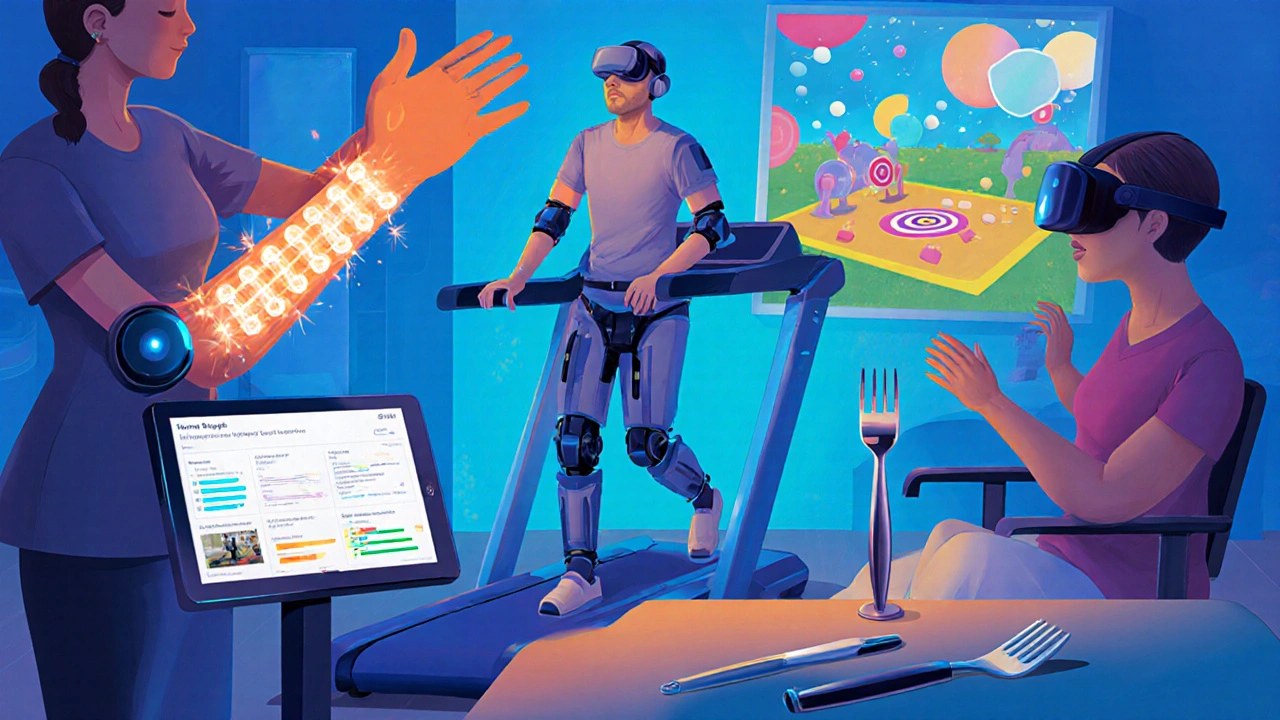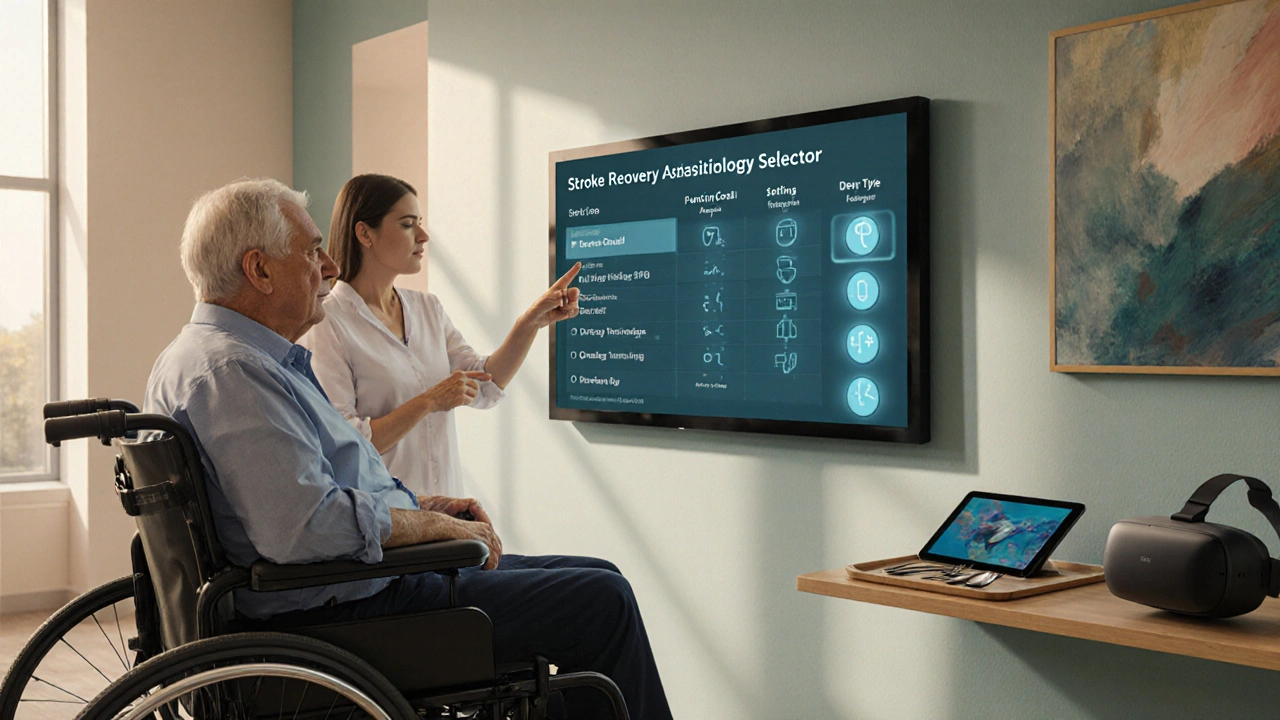Stroke Recovery Assistive Technology Selector
Enter your preferences and click "Find Recommended Assistive Technologies" to see personalized recommendations.
When a stroke hits, the road to regaining independence can feel like a maze. Traditional therapy still matters, but a growing arsenal of devices and software is reshaping the journey. These tools aren’t science‑fiction gadgets; they’re practical solutions that help survivors rebuild movement, speech, and daily routines faster and with less frustration.
Quick Take
- Assistive technology (AT) covers hardware and software that compensate for lost functions after a stroke.
- Key categories include electrical stimulation, robotic exoskeletons, virtual‑reality systems, mobile health apps, and speech‑generating devices.
- Choosing the right AT starts with a clear rehab goal, budget, and support network.
- Evidence shows AT can boost motor recovery by 20‑30% and improve speech outcomes when paired with therapy.
- Future trends point to AI‑driven wearables and cloud‑based telerehab platforms.
Understanding Assistive Technology in Stroke Recovery
When it comes to post‑stroke care, Assistive Technology is a range of devices and software designed to support people with physical, sensory, or cognitive impairments. It works hand‑in‑hand with conventional physiotherapy, occupational therapy, and speech‑language pathology. The goal is simple: give the brain the best possible feedback loop so neurons can relearn tasks they once performed effortlessly.
Stroke, medically defined as Stroke is an interruption of blood flow to the brain that can cause lasting neurological deficits, often leaves survivors struggling with muscle weakness, spasticity, balance loss, and communication challenges. assistive technology steps in to bridge the gap between what the body can still do and what the daily world demands.
Key Categories of Assistive Technology
Below are the most common AT families you’ll encounter in a modern stroke rehab program.
Functional Electrical Stimulation (FES)
Functional Electrical Stimulation is a technique that applies low‑level electrical currents to weakened muscles to trigger contractions. When synchronized with a patient’s intent to move, FES can reinforce neural pathways and reduce spasticity.
Robotic Exoskeletons
Robotic Exoskeleton is a wearable frame that supports joint movement and provides graded assistance during gait training. Devices like the Ekso and ReWalk allow users to practice walking with partial body‑weight support.
Virtual Reality (VR) Rehabilitation
Virtual Reality Rehabilitation is an immersive digital environment that simulates real‑world tasks to motivate motor relearning. Studies show VR can increase patient engagement and improve upper‑limb function by up to 25%.
Mobile Health Applications
Mobile Health App is a smartphone‑based platform that delivers exercise videos, progress tracking, and remote clinician feedback. Popular apps such as PTPal and Stroke Rehab Coach let patients practice at home while clinicians monitor adherence.
Speech‑Generating Devices
Speech‑Generating Device is an electronic aid that converts typed or selected text into spoken words for individuals with aphasia. These tools can restore conversational ability and reduce social isolation.
Adaptive Utensils & Daily Living Aids
Adaptive Utensil is a modified fork, spoon, or cup with ergonomic grips, weighted handles, or built‑in stabilizers. Simple changes like these enable independence in eating, dressing, and grooming.
Choosing the Right Device: A Practical Checklist
- Define the rehab goal. Is the priority regaining walking, arm function, speech, or daily living tasks?
- Assess baseline ability. Use tools like the Fugl‑Meyer Assessment to gauge motor scores.
- Consider the setting. Hospital‑based exoskeletons versus home‑use apps have different logistical needs.
- Budget and insurance coverage. Many AT devices qualify for NHS or private reimbursement, but out‑of‑pocket costs vary widely.
- Support network. Family or caregiver involvement is crucial for device setup and daily use.
- Evidence base. Prioritize tools with peer‑reviewed studies demonstrating functional gains.

Integrating AT into a Rehab Plan
- Initial evaluation. A neurorehabilitation specialist (Neurorehabilitation is the interdisciplinary approach to restore neurological function after injury) identifies deficits and matches them to suitable AT.
- Device training. Therapists demonstrate proper use, safety checks, and troubleshooting.
- Scheduled practice. Combine AT‑assisted exercises with conventional therapy 3‑5 times per week.
- Progress monitoring. Use built‑in sensors or app dashboards to track repetitions, range of motion, and patient‑reported outcomes.
- Iterative adjustment. As abilities improve, modify assistance levels or switch to a more advanced device.
Evidence of Benefits
Randomized controlled trials (RCTs) across the last decade paint a clear picture:
- FES added to conventional physiotherapy improved wrist extension strength by 18% compared with therapy alone (Journal of NeuroEngineering, 2022).
- Robotic exoskeleton training yielded a mean increase of 5 points on the Berg Balance Scale over eight weeks (Clinical Rehabilitation, 2023).
- VR‑based upper‑limb tasks produced a 30% faster reduction in motor neglect scores versus standard OT (Stroke, 2024).
- Mobile health apps increased home‑exercise adherence from 45% to 78% in a multi‑site study (BMJ Digital Health, 2025).
Collectively, these data suggest AT can accelerate functional gains, reduce hospital stays, and improve quality of life when used responsibly.
Common Pitfalls & How to Avoid Them
- Over‑reliance on devices. AT should augment, not replace, active therapist‑guided movement.
- Poor fit or calibration. Ill‑fitted exoskeletons can cause skin breakdown or abnormal gait patterns.
- Technology fatigue. Rotate between devices and rest periods to keep motivation high.
- Lack of training for caregivers. Provide hands‑on sessions and printed SOPs to prevent misuse.
- Neglecting data privacy. Verify that mobile apps comply with GDPR and have secure data storage.
Emerging Trends: What’s Coming Next?
Artificial‑intelligence algorithms are learning to predict optimal assistance levels in real time, creating truly adaptive exoskeletons. Wearable inertial sensors are feeding cloud‑based Telehealth Platform is a remote‑care system that connects patients with therapists via video and data streams, allowing clinicians to adjust therapy without a clinic visit.
In the next five years, we expect:
- Hybrid VR‑robotic suites that blend immersive environments with physical assistance.
- Voice‑activated, AI‑driven speech‑generating devices that adapt vocabularies to each user’s daily context.
- Insurance policies that list AT devices as standard post‑stroke coverage, reducing out‑of‑pocket barriers.
Quick Reference Checklist
- Identify specific functional goal.
- Match goal to device category (FES, exoskeleton, VR, app, speech aid).
- Confirm evidence base and insurance eligibility.
- Arrange therapist‑led training and caregiver onboarding.
- Set measurable milestones (e.g., 10% gait speed increase in 6 weeks).
- Review progress monthly and adjust assistance level.

Frequently Asked Questions
Can I use assistive technology at home without a therapist?
Yes, many devices-especially mobile apps, adaptive utensils, and simple FES units-are designed for independent home use. However, a therapist should initially set the parameters and periodically review progress to ensure safety and efficacy.
Will my NHS insurance cover a robotic exoskeleton?
Coverage varies by region and clinical indication. In England, the NHS may fund exoskeletons for patients who meet strict criteria-usually those with severe gait impairment who have not responded to conventional therapy. It’s best to discuss eligibility with your rehab team and a clinical commissioning group.
How long should I use functional electrical stimulation each day?
Most protocols recommend 20‑30 minutes per session, 3‑5 times per week, focusing on the affected limb during active attempts to move. Always follow the therapist‑prescribed intensity to avoid muscle fatigue.
Are virtual‑reality systems safe for stroke survivors with balance issues?
When used in a supervised setting, VR is safe and can actually improve balance by providing controlled, repeatable challenges. At home, choose seated or low‑impact VR experiences and ensure a clear, obstacle‑free space.
What’s the biggest factor in deciding which device to purchase?
Fit with the patient’s specific functional goal. A device that addresses the most limiting deficit-whether it’s arm reach, walking speed, or speech-will provide the highest return on investment.
| Technology | Primary Function | Typical Users | Cost Range (GBP) | Evidence Level |
|---|---|---|---|---|
| Functional Electrical Stimulation | Muscle activation & spasticity reduction | Upper‑limb & ankle weakness | £1,500‑£4,000 | High (RCTs, 2020‑2024) |
| Robotic Exoskeleton | Gait assistance & weight bearing | Severe gait impairment | £15,000‑£45,000 | Moderate‑High (Meta‑analysis 2023) |
| Virtual Reality Rehab | Task‑specific motor training | Upper‑limb & coordination | £800‑£3,200 (system) | Moderate (Pilot studies 2022‑2024) |
| Mobile Health App | Exercise tracking & remote feedback | Home‑based self‑practice | Free‑£120/year | Low‑Moderate (Observational 2023‑2025) |


12 Comments
October 3, 2025 Danielle Ryan
Wow-this deep‑dive into assistive tech feels like a secret revelation, doesn’t it??? The way they hide the true power of exoskeletons behind NHS paperwork is practically a covert operation!!! I can’t help but wonder who’s really pulling the strings-big‑tech conglomerates, shadowy health insurers, or perhaps an underground network of “rehab‑elitists” feeding us curated data!!! The colors in that table? They’re not just aesthetic, they’re a signal-£15,000‑£45,000, a price tag that screams “only the privileged may walk again”!!! It’s like the tech itself is whispering conspiracies into the patient’s ear, promising freedom while the system watches!!!
October 10, 2025 Robyn Chowdhury
Indeed, the article presents a thorough overview, yet its tone remains restrained-perhaps deliberately so. While the facts are solid, one senses a lingering drama beneath the surface, as if the author is hesitating to fully expose the stakes. 🤔📊
October 17, 2025 Deb Kovach
Let’s break down the practical steps for anyone considering these technologies, starting with functional electrical stimulation (FES). First, schedule an assessment with a certified neuro‑rehabilitation therapist to determine which muscle groups would benefit most. The therapist will then set the stimulation parameters-frequency, pulse width, and intensity-tailored to the patient’s residual motor control. Typically, a 20‑30 minute session, three to five times per week, yields measurable improvements in muscle activation and spasticity reduction. 📈
Next, evaluate the suitability of a robotic exoskeleton. This requires a baseline gait analysis, often conducted on a treadmill with motion capture or wearable sensors. If the patient demonstrates a minimum of 20% voluntary hip and knee extension, the exoskeleton can be introduced in a supervised setting for safety. Initial sessions focus on weight‑bearing tolerance and balance training, gradually increasing step length and speed. The literature suggests a median improvement of five points on the Berg Balance Scale after eight weeks of consistent use. 🦾
For those preferring a home‑based solution, virtual reality (VR) platforms have become increasingly affordable. A modest headset paired with a motion‑tracked controller can simulate reaching tasks, encouraging neuroplasticity through repetitive, goal‑directed movements. Studies show up to a 30% faster reduction in motor neglect scores when VR is combined with conventional therapy. Remember to keep the play area clear of obstacles to prevent falls. 🕶️
Mobile health apps serve as an excellent adjunct for self‑monitoring. Choose an app that offers secure data transmission, customizable exercise libraries, and direct messaging with a clinician. Consistent logging of daily repetitions helps maintain motivation and provides objective metrics for the care team. Finally, don’t overlook the importance of adaptive utensils for activities of daily living; these low‑cost items can dramatically improve independence and quality of life. 😊
In summary, successful integration hinges on a structured evaluation, personalized device training, and rigorous progress tracking. By aligning the technology with the patient’s specific functional goals, budget, and support network, the chances of meaningful recovery increase substantially.
October 23, 2025 Sarah Pearce
i guess ths tech is nice but u really need 2 many 2 pay!!! lol can u even afford it? the price tags are insane!!!
October 30, 2025 Akhil Khanna
Absolutely 👍! Just remember that the biggest factor is matching the device to the patient’s personal goal-whether it’s walking, gripping, or chatting. Even a small tweak can make a huge difference, and the community here is always ready to help! 😊🌟
November 6, 2025 Zac James
From a cultural perspective, it’s fascinating how assistive technologies are being adapted worldwide-from low‑cost 3D‑printed prosthetics in Kenya to AI‑driven speech aides in Japan. This global exchange enriches the field and ensures innovations are inclusive of diverse needs.
November 13, 2025 Arthur Verdier
Oh sure, “global exchange” while the big corporations lock patents tighter than a vault. They want us to think it’s all collaborative, but it’s really a data‑harvesting scheme-every movement you make is fed back to their servers for profit!!!
November 20, 2025 Breanna Mitchell
Let’s stay positive! The international collaborations are actually opening doors for patients who previously had no options. Every new partnership means more affordable, user‑friendly gear hitting the market soon! 🌈
November 27, 2025 Richard Gerhart
Yo, if you’re worried about data, look for devices that are open‑source or have clear privacy policies. Many newer exoskeletons now encrypt the telemetry, so your steps stay private-check the specs before you buy! 👍
December 4, 2025 Kim M
🤷♀️ They’re probably spying on us anyway! 🕵️♂️
December 10, 2025 Martin Gilmore
While you all romanticize “global exchange,” let’s not forget the linguistic precision required in medical documentation-improper terminology can jeopardize patient safety!!! And, for the love of the flag, stop importing half‑baked tech that hasn’t been vetted by our own brilliant engineers!!!
December 17, 2025 Amy Aims
Hey everyone, great points all around! It’s exciting to see both the heartfelt stories and the tech specs-keeps the conversation lively and hopeful 😊.
Write a comment